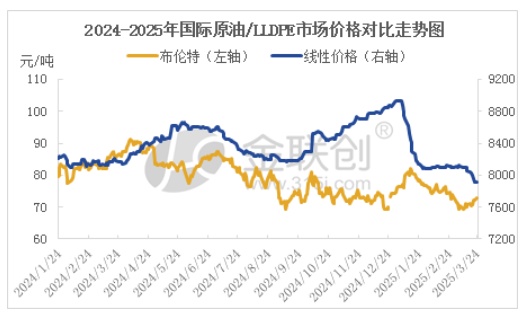The supply and demand face new changes, how will the polyethylene trend perform in the second quarter?
Certainly, here's the translation of "导语" into English directly as a title or introductory phrase: **Introduction** Please note that "导语" more specifically translates to "Preface" or "Introduction" in the context of a book or document. The translation provided is a general equivalence.As the end of the month approaches, buoyed by the rebound in crude oil and plastic futures, market bearish sentiment is being corrected, and the spot market for polyethylene is reporting a stabilization after declines. However, with the onset of the second quarter, the polyethylene market supply and demand landscape is facing changes. On one hand, new capacity comes online while, in the second quarter, the period of plant maintenance begins, weaving together a mix of supply shortages and surpluses. On the other hand, the downturn in the startup rate of downstream agricultural films and difficulties in packaging film demand exceeding expectations suggest that the imbalance in supply and demand may further intensify. The polyethylene market in the second quarter is thus expected to present both opportunities and challenges.
Expected new capacity will be put into production, suppressing supply growth.
In the second quarter of 2025, the domestic polyethylene market will see a new wave of concentrated release of new capacity. Among them, the new plants of ExxonMobil Huizhou, Baofeng Inner Mongolia #3, and Shandong Xind 시대 are scheduled to start up in April, and the pressure from the new capacity will gradually materialize, suppressing market prices.
Meanwhile, the number of domestic PE devices undergoing maintenance in April has notably increased, gradually entering the peak season for major repairs. It is estimated that the main maintenance companies involved in the second quarter will include Yangzi BASF, Zhejiang Petrochemical, Shanghai Petrochemical, Qilu Petrochemical, Yan Shan Petrochemical, and Tianjin Petrochemical, mainly high-pressure devices, which is expected to benefit the LDPE market supply in the second quarter. Although spring maintenance has led to reduced domestic supply, overall polyethylene supply is still expected to be unfavorable due to the pressure of new capacity addition.
Demand marginally expected to weaken.
As one of the main downstream demand sectors for polyethylene, the agricultural film industry is expected to reach its annual peak operating rate in late March and then gradually decline. This is mainly due to the gradual completion of spring plowing and sowing work, leading to a natural decrease in demand for agricultural films, and entering the second quarter, it will gradually enter the off-season for demand. The demand growth in the packaging film sector also faces certain bottlenecks. With the development of the e-commerce industry gradually stabilizing, the demand growth rate for packaging films has slowed down. Additionally, the demand for other polyethylene downstream products such as construction and pipes is unlikely to show unexpected growth, making it difficult for overall demand increases to match the supply growth rate.
Crude oil rebounds from lows, market pessimism eases.

NearDue to escalating geopolitical conflicts and the impact of US tariff policies, crude oil prices have continued to rebound, which has boosted market confidence to some extent and mitigated bearish sentiment. Under the backdrop of rising crude oil prices, traders and downstream enterprises have strengthened their expectations for a temporary bottom in polyethylene prices, leading to increased purchasing intentions and temporarily stabilizing polyethylene market offers. However, several sources indicate that the OPEC+ organization is considering extending its oil production increase plan for a second consecutive month in May. Furthermore, without further deterioration of geopolitical situations or other unexpected positive developments, the rebound potential for crude oil is still expected to be limited.
In summary, in the short term, the market's pessimistic sentiment has somewhat eased, but the supply of spot polyethylene is relatively ample, and the destocking process is slow. It is expected that the market will maintain a fluctuating pattern. The futures market is constrained by forward supply pressure and macroeconomic factors, limiting the upward potential.
In the medium to long term, with the gradual realization of increased supply and the seasonal weakening of demand, the accumulation pressure in the polyethylene market may intensify after April, further suppressing prices. However, the second quarter marks the maintenance season, and there are still some positive factors on the supply side. Market participants need to closely monitor the impact of factors such as domestic and international macroeconomic conditions, geopolitical situations, industry policy changes, and plant operating conditions on the market.
【Copyright and Disclaimer】The above information is collected and organized by PlastMatch. The copyright belongs to the original author. This article is reprinted for the purpose of providing more information, and it does not imply that PlastMatch endorses the views expressed in the article or guarantees its accuracy. If there are any errors in the source attribution or if your legitimate rights have been infringed, please contact us, and we will promptly correct or remove the content. If other media, websites, or individuals use the aforementioned content, they must clearly indicate the original source and origin of the work and assume legal responsibility on their own.
Most Popular
-

List Released! Mexico Announces 50% Tariff On 1,371 China Product Categories
-

Nissan Cuts Production of New Leaf EV in Half Due to Battery Shortage
-

New Breakthrough in Domestic Adiponitrile! Observing the Rise of China's Nylon Industry Chain from Tianchen Qixiang's Production
-

Dow, Wanhua, Huntsman Intensively Raise Prices! Who Controls the Global MDI Prices?
-

Mexico officially imposes tariffs on 1,400 chinese products, with rates up to 50%






